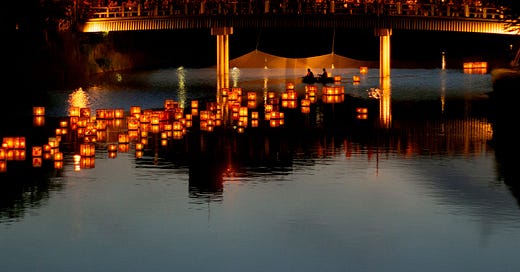As August folds into September, a subtle transformation sweeps across Japan. The heat of summer begins to mellow, and the country finds itself at the cusp of seasons’ change. This transitional moment, marked by a retreat of the cicadas and the first hints of autumn cool, is a time of reflection, nostalgia, and quiet celebration—a rhythm to life in Japan.
The end of summer is not merely a date on the calendar; it’s the cool breeze that starts to whisper through the trees, the shortening days, and the golden hour that seems to linger just a bit longer, as if savoring the last warmth of the season. Natsu no owari (夏の終わり) holds a special place in the hearts of many, evoking a mix of melancholy and contentment—a bittersweet acknowledgment that another season has passed.
One of the most poignant expressions of this time is found in Japan’s summer festivals, or matsuri. These vibrant celebrations, often held in late August, serve as both the climax and the farewell to summer. In towns and cities across the country, locals don their yukata (light cotton kimonos), and the streets come alive with the sound of drums, flutes, and the laughter of festival-goers. There’s a palpable energy in the air, a final burst of liveliness before the more subdued months of autumn.
The Bon Odori (盆踊り) dance is a quintessential part of these festivals, where communities come together to honor their ancestors through rhythmic, circular dances. The origins of Bon Odori are rooted in the Buddhist tradition of welcoming spirits back to the world of the living during the Obon period. While Obon itself is held earlier in the summer, many regions continue the festivities into late August, blending spirituality with the joy of summer’s last hurrah.
Another beloved tradition marking the end of summer is the fireworks display, or hanabi taikai (花火大会). These dazzling spectacles light up the night skies throughout Japan, drawing massive crowds to riverbanks, parks, and beaches. The fireworks are not merely an entertainment; they symbolize the fleeting nature of life, mirroring the transient beauty of cherry blossoms in spring. As the sky explodes in color, there’s a collective sense of marvel tinged with the awareness that these moments, like summer itself, are fleeting.
But perhaps the most intimate way the Japanese mark the end of summer is through a quiet appreciation of nature’s subtle changes. The evening cicada songs, a deafening chorus just a few weeks before, begin to quiet down as the creatures reach the end of their short lives. The arrival of higurashi (evening cicadas) and the first chirps of suzumushi (bell crickets) will herald the approach of autumn. These sounds, familiar yet different, remind us of the impermanence of time—a concept known as mono no aware (物の哀れ), the awareness of the transient nature of all things.
As summer draws to a close, Japanese people often partake in small, personal rituals to bid farewell to the season. A final visit to the beach, a last sip of chilled ramune soda, or an evening stroll to catch the remnants of a summer sunset—all serve as quiet acknowledgments of summer’s end. It’s a time for introspection, for storing memories of sun-soaked days and warm nights before the cool embrace of autumn takes hold.
In Japan, the end of summer is not a sudden shift but a gentle transition—a time of both celebration and quietude, where the joy of the season’s peak gracefully gives way to the introspective mood of autumn. As the last fireworks fade and the final notes of Bon Odori linger in the air, Japan welcomes the coming season with a deep sense of gratitude, carrying the warmth of summer into the colder months ahead.



